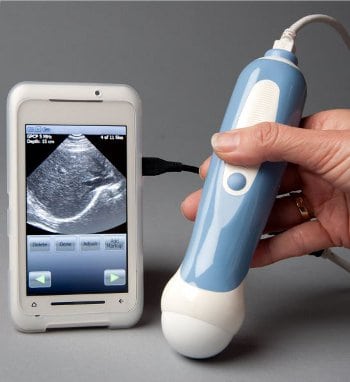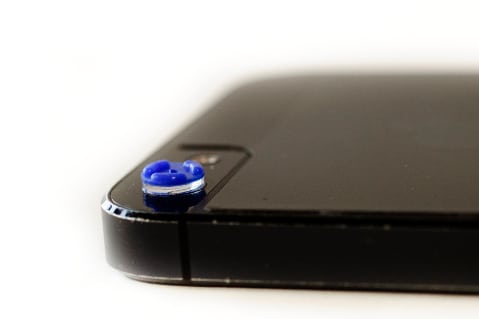Worldwide, Star Trek has sunken its fictional hooks into our daily lives in ways of which many of us are unaware. And, in a sense, those hooks are about to sink deeper. When Martin Cooper invented the personal cell phone while working for Motorola in the 1970s, he admitted that Captain Kirk’s communicator was his inspiration. Since Cooper’s “brick,” so called for its blocky shape and heavy weight, has given way to smart phones, another Star Trek device has a shot at entering the real world.
Remember the tricorder? It’s a multi-purpose sensor that, with a peripheral attachment, becomes a medical scanner. Now, a start-up mobile health company has found a way to merge a transducer with a phone, forming the first truly mobile ultrasonograph machine. The communicator meets the tricorder, at least within the limits of real-life technology.
This cheap, mobile technology has deep implications for healthcare in the United States, where it will first become available, and in developing countries. We were enticed, so we spoke with Sailesh Chutani, CEO and co-founder of Mobisante, the start-up behind the device.
Ultrasound: the next stethoscope?
“You’ll hear people talk about ultrasound as being the next stethoscope,” Chutani says. Like Gene Rodenberry, Chutani also foresees a future in which doctors can scan their patients during routine check-ups. “There’s no reason why your general practitioner could not screen you for aneurisms, bladder stones and such,” he says. “A lot of screening you can do to pick up potential problems.”
Chutani’s company, Mobisante, based in Redmond, Washington, is testing its MobiUS ultrasound devices in clinics now. With the US Food and Drug Administration’s approval granted in February, the company plans to begin sales by the third quarter of this year. The initial run could cost up to $8000, including the phone. The price could drop as production increases, but even at its current rate, it’s about $20,000 cheaper than the lowest-priced traditional machines.
It lacks the power and depth of a larger machine, obviously, and in some cases doctors will want traditional scans. But this device’s strengths are its portability and cost. Mobisante posted sample images on its site here.

Photo courtesy of Mobisante
MobiUS explained
At its core, the device is a software package for a smart phone. When coupled with a modified ultrasound transducer that plugs into the phone’s USB port, the software converts the phone into an ultrasound machine. It runs on a Windows operating system and the only Windows phone with USB support available now is Toshiba’s TG01. Future phone models could also support the peripheral transducer, Chutani says and his company plans to pair the device with some tablets.
The technology can put ultrasound into rural clinics in the United States for the first time. It can also equip first responders, family doctors, nurses inserting IV lines and, of course, clinics in developing countries.
“People understand the value of ultrasound. We changed the equation by asking what happens when you make this a lot more convenient and a lot more affordable,” Chutani says.
There is preliminary data on its impact during clinical tests. In one trauma center, the mobile devices boosted the rate of ultrasound screening from once per day to once per hour, Chutani says. In the future, he plans to run the device through larger randomized, controlled trials, which are the gold standard for medical science.
Life savers
Before settling on a first-run in the United States, Chutani’s team had sights set on markets in the developing world. “We thought we’d start in developing countries, but it may be a bit more expensive than what the market can afford,” he says. He is rethinking that strategy and may introduce the device in the developing world after US production begins.
In the developing world, especially, mobile ultrasound has the power to save millions of lives. Every year, 500,000 women die from complications of pregnancy and childbirth, and 99 percent of those occur in developing countries, the United Nations reports. Most of those deaths are avoidable, and screening is a first step toward their prevention, Chutani says.
Mobile ultrasound can save lives, money and time in the developed world as well.
“These systems are affordable enough that each of our clinics in rural eastern Washington could have one, which means we won’t have to send our patients to facilities many hours away,” Greg Brandengurg, CEO of Columbia Basin Health Association in Othello, Washington, said in a statement (pdf). Brandenburg’s clinics tested a version of the device. “Furthermore, since the devices are connected, it is easy to get a second opinion from remote experts,” Brandenburg says.
MobiUS on YouTube
Chutani is a former Microsoft executive who worked in Windows Mobile. Before that, he managed a Microsoft fund that invested in emerging technologies. One of the ideas that appealed to him was an ultrasound prototype by his current partner, David Zar. Zar explains the latest iteration of their device in this short YouTube clip below.


Hello,
I think this is a wonderful thing and was wondering if you are testing this? I would like to try this product.
HELLO, I WOULD LIKE TO TRY ALSO, THE APPLICATION IS NOT AVAILABLE ON THE SITE, HOW TO DO?
Hi, how soon it Will be available in USA? I woild like to try and buy 🙂
And if it already exist , in what countries it available ?
THanks
How do i order this product.
Very urgent requirement for developing countries
Plz send details
How does some one get false hope
I want get this port ultrasound in your mobil phone